 W
WThe Auchinleck Manuscript, NLS Adv. MS 19.2.1, currently forms part of the collection of the National Library of Scotland. It is an illuminated manuscript copied on parchment in the 14th century in London. The manuscript provides a glimpse of a time of political tension and social change in England. The English were continuing to reclaim their language and national identity, and to distance themselves from the Norman conquerors who had taken over the country after the Battle of Hastings 300 years before.
 W
WThe Birds' Head Haggadah is the oldest surviving illuminated Ashkenazi Passover Haggadah. The manuscript, produced in the Upper Rhine region of Southern Germany in the early 14th century, contains the full Hebrew text of the Haggadah, a ritual text recounting the story of Passover – the liberation of the Israelites from slavery in ancient Egypt – which is recited by participants at a Passover Seder. The text is executed in block calligraphy and accompanied by colorful illustrations of Jews performing the Seder practices and reenacting Jewish historical events. The Birds' Head Haggadah is so called because all Jewish men, women, and children depicted in the manuscript have human bodies with the faces and beaks of birds. Non-Jewish and non-human faces are blank or blurred. Numerous theories have been advanced to explain the unusual iconography, usually tied to Jewish aniconism. The Haggadah is in the possession of the Israel Museum in Jerusalem, where it is on permanent exhibition.
 W
WThe Book of Ballymote, was written in 1390 or 1391 in or near the town of Ballymote, now in County Sligo, but then in the tuath of Corann.
 W
WThe Kitab al-Bulhan, or Book of Wonders, or Book of Surprises, is a mainly 14th century Arabic manuscript compiled – and possibly illustrated – by Abd al-Hasan Al-Isfahani. The codex was probably bound during the reign of Jalayirid Sultan Ahmad (1382-1410) at Baghdad, and includes texts on astronomy, astrology, geomancy and a section of full-page illustrated plates dedicated to each discourse topic, e.g. a folktale, a sign of the zodiac, a prophet, etc.
 W
WThe Breviary of San Michele della Chiusa is a manuscript liturgical book of 1315 in two volumes: the "Santorale" and the "Temporale" for a total of 1390 pages.
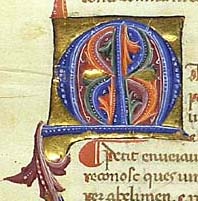 W
WThe Cançoner Gil is an Occitan chansonnier produced in Catalonia in the middle of the 14th century. In the systematic nomenclature of Occitanists, it is typically named MS Sg, but as Z in the reassignment of letter names by François Zufferey. It is numbered MS 146 in the Biblioteca de Catalunya in Barcelona where it now resides.
 W
WThe Chronicon Pictum is a medieval illustrated chronicle from the Kingdom of Hungary from the second half of the fourteenth century. It represents the international artistic style of the royal courts in the court of Louis I of Hungary.
 W
WThe Cloisters Apocalypse, MS 68.174 is a small French illuminated manuscript dated c. 1330. It is based on John the Evangelist's New Testament visions and apocalyptic revelation. According to Christian legend John was exiled c. 95AD to the Aegean island of Patmos, where he wrote the Book of Revelation. The book evokes John's despair and isolation while exiled, and his prophecy of events and terrors of the last days.
 W
WThe Cloisters Hebrew Bible is a Hebrew Bible codex made in the Kingdom of Castile from the early to mid-14th century, with an approximate date prior to 1366. The Metropolitan Museum of Art acquired this manuscript from the collection of Jacqui Safra from Sothebys Judaica auction in December 20, 2017.
 W
WThe Golden Haggadah is an illuminated manuscript originating around c. 1320-1330 in the region of Catalonia. It is an example of an Illustrated Haggadah, a religious text for Jewish Passover. It contains many lavish illustrations in the High Gothic style with Italianate influence, and is perhaps one of the most distinguished illustrated manuscripts created in Spain. The Golden Haggadah currently resides in the British Library and can be fully viewed as part of their Digitized Manuscript Collection MS 27210.
 W
WThe Gorleston Psalter is a 14th-century manuscript notable for containing early music instruction and for its humorous marginalia. It is named for the town of Gorleston in Norfolk.
 W
WThe Gospels of Tsar Ivan Alexander, Tetraevangelia of Ivan Alexander, or Four Gospels of Ivan Alexander is an illuminated manuscript Gospel Book, written and illustrated in 1355–1356 for Tsar Ivan Alexander of the Second Bulgarian Empire. The manuscript is regarded as one of the most important manuscripts of medieval Bulgarian culture, and has been described as "the most celebrated work of art produced in Bulgaria before it fell to the Turks in 1393".
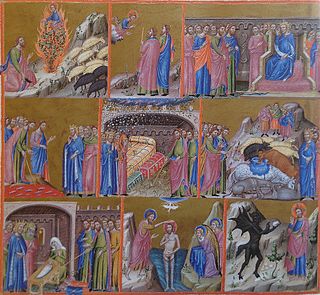 W
WThe Great Canterbury Psalter, Anglo-Catalan Psalter or Paris Psalter is an early 13th- and mid 14th-century illuminated manuscript with the shelfmark MS lat. 8846 in the Bibliothèque nationale de France in Paris. It was made in two different locations and moments in time: at Canterbury around 1200 and in Catalonia around 1340. It is the last of a series of copies of the Utrecht Psalter made in Canterbury, following the Harley Psalter and the Eadwine Psalter.
 W
WThe Great Mongol Shahnameh, also known as the Demotte Shahnameh or Great Ilkhanid Shahnama, is an illustrated manuscript of the Shahnameh, the national epic of Greater Iran. It is the oldest surviving illustrated manuscript of the Shahnameh, probably dating to the 1330s, and in its original form, which has not been recorded, was probably planned to consist of about 280 folios with 190 illustrations, bound in two volumes, although it is thought it was never completed. It is the largest early book in the tradition of the Persian miniature, in which it is "the most magnificent manuscript of the fourteenth century", "supremely ambitious, almost awe-inspiring", and "has received almost universal acclaim for the emotional intensity, eclectic style, artistic mastery and grandeur of its illustrations".
 W
WThe Grey-FitzPayn Hours is an illuminated book of hours formerly thought to have been commissioned by Sir Richard de Grey for his bride Joan FitzPayn, but now thought to have been made for members of the Pabenham and Clifford families, produced in the English Midlands around 1300 to 1308. It follows the Use of Sarum, standard in England from the mid-13th century onwards. It is 24.5 cm by 17 cm, with 93 folios, 2 full-page miniatures, 3 large figured initials and other ornamental initials and borders. It is now Cambridge, Fitzwilliam Museum, MS. 242.
 W
WThe Silesian manuscript, otherwise known as the Hedwig Codex, and also known as the Codex of Lubin, is a medieval illuminated manuscript from the mid-14th century. Through its sixty-one colored drawings and inscriptions in "comics' style" it tells the life story of Saint Hedwig of Silesia, spouse of the Silesian Piast duke Henry the Bearded, her family, and events related to her canonization (1267). The Hedwig Codex details both the married life of the Hedwig of Silesia and her life within the Cistercian nunnery of Trebnitz. This art piece, a fine example of Central European Gothic art, is valued especially for its depictions of the Tartar invasion of Europe (Silesia).
 W
WThe Holkham Bible is an illustrated collection of biblical and apocryphal stories in Norman French. It was produced in England during the decades before 1350 for use by an unidentified Dominican friar. The illustrations depict the stories in contemporary English settings, making it a visual source on medieval English society. Previously part of the library of Holkham Hall, Norfolk, the Holkham Bible is now held by the British Library.
 W
WThe Hours of Giangaleazzo Visconti is a Roman-liturgy illuminated Book of Hours that was commissioned by the ruler of Milan, Gian Galeazzo Visconti, in Italy in the late 14th century. A Book of Hours is a personal prayer book that contained, in part, the Hours of the Virgin, a daily devotional that was popular at the time. This particular Book of Hours was created by two master illuminators, beginning with Giovannino dei Grassi before his death, and completed by Luchino Belbello da Pavia.
 W
WThe Hours of Jeanne d'Evreux is an illuminated book of hours in the Gothic style. According to the usual account, it was created between 1324 and 1328 by Jean Pucelle for Jeanne d'Evreux, the third wife of Charles IV of France. It was sold in 1954 to the Metropolitan Museum of Art in New York where it is now part of the collection held at The Cloisters, and usually on display. The book is very lavishly decorated, mostly in grisaille drawings, and is a highly important example of an early royal book of hours, a type of book designed for the personal devotions of a wealthy lay-person, which was then less than a century old. It has been described as "the high point of Parisian court painting", showing "the unprecedentedly refined artistic tastes of the time".
 W
WThe Hours of Jeanne de Navarre is an illuminated book of hours with miniatures painted by Jean Le Noir. The book was commissioned by Philip VI of Valois and his wife, Blanche de Navarre, for Jeanne de Navarre, Queen of Navarre. The book was created sometime between 1336 and 1340 and is now in the Bibliothèque Nationale, Paris.
 W
WThe Hours of Philip the Bold is a late 14th-century illuminated book of hours produced in Paris for Philip the Bold, Duke of Burgundy (1363-1404). It contains illustrated calendars, figured initials and 11 large miniatures with ivy borders, following the Paris liturgy. The manuscript has a devotional use. Philip reportedly recited his daily prayers from this manuscript. His hours, which contains almost 200 images, is one of the most worldly manuscripts to survive from the library of the Burgundian Dukes. It is now MS. 3-1954 in the Fitzwilliam Museum, Cambridge.
 W
WThe Hours of Saint-Omer is an illuminated book of hours produced in Northern France for the use of Marguerite de Beaujeu around 1320-1330. It follows the Arras liturgy. The manuscript gains its name from the fact that its calendar gives special attention to the church and the relics of Saint Omer in the town of Saint-Omer.
 W
WThe Howard Psalter and Hours is a 14th-century illuminated prayerbook. It includes a liturgical Psalter with canticles and litany, the Office of the Dead, a calendar of East Anglian origin and an incomplete Hours of the Passion. It was produced between 1310 and 1320. It is written in Latin in a Gothic script in two columns per page. There are 115 extant folios which measure 360 by 235 mm. The text block occupies an area of 250 by 166 mm. It is bound together with the De Lisle Psalter, a contemporary psalter.
 W
WThe Liber Regalis is an English medieval illuminated manuscript which was, most likely, compiled in 1382 to provide details for the coronation service for Richard II's consort, Anne of Bohemia. Other sources suggest that it may have been compiled in 1308 for the coronation of Edward II. The Liber Regalis contains the ordo (order) for the following events: the coronation of a king, a king and queen and a queen alone, and details regarding the funeral of a king; each liturgy opens with a full-page illustration depicting the event.
 W
WLiber viaticus is a breviary made sometime in the 1350s, at the latest in 1364, for Bishop John of Neumarkt. This is an illuminated manuscript of 319 sheets in relatively good condition preserved to this day and deposited in the National Museum Library, Prague.
 W
WBibliothèque Nationale, MS fr. 2090-2092 is an illuminated manuscript of The Life of Saint Denis, a hagiographical account of the life and martyrdom of Saint Denis, the first Bishop of Paris. The manuscript was produced in Paris and was begun at the request of John de Pontoise, Abbot of the Abbey of Saint Denis during the reign of Philip IV. The manuscript was completed in 1317 and presented by the abbot to Philip V.
 W
WThe Llibre dels fets, originally spelled Libre dels feyts, is the autobiographical chronicle of the reign of James I of Aragon (1213–1276). It is written in Old Catalan in the first person and is the first chronologically of the four works classified as The Four Great Catalan Chronicles, all belonging to the early medieval Crown of Aragon, and its first royal dynasty, the House of Barcelona. James I inherited as a child the titles of King of Aragon, Count of Barcelona, and Lord of Montpellier, but also became by conquest King of Majorca and King of Valencia. James emphasises in his chronicles his conquest of Majorca (1229) and of Valencia (1238).
 W
WThe Llibre Vermell de Montserrat is a manuscript collection of devotional texts containing, amongst others, some late medieval songs. The 14th-century manuscript was compiled in and is still located at the monastery of Montserrat outside Barcelona in Catalonia (Spain).
 W
WThe Maastricht Hours is a book of hours that was produced in the vicinity of Liège early in the 14th century and is now among the Stowe manuscripts of the British Library. It is known for its colourful and imaginative miniatures, often on animal themes. It has been fully digitised and is available on the British Library website.
 W
WMinuscule 480, δ 462, is a Greek minuscule manuscript of the New Testament, on parchment. It is dated by a colophon to the year 1366. The manuscript is lacunose. The manuscript was adapted for liturgical use. It has marginalia. It contains liturgical books with hagiographies: Synaxarion and Menologion.
 W
WMissal of duke Novak was a 14th-century Glagolitic missal. The letters of the missal were later used for the first Croatian printed book Missale Romanum Glagolitice.
 W
WThe Munich Serbian Psalter is a 14th-century illuminated psalter written in Church Slavonic of the Serbian recension. With its 229 leaves illustrated with 148 miniatures, it is regarded as the most extensively illuminated Serbian manuscript book. It was written after 1370 in Moravian Serbia, either for its ruler Prince Lazar, or more likely, for his successor Stefan Lazarević. The book was rebound in 1630 by Serbian Patriarch Pajsije. It was taken to Bavaria in the late 17th century, and has been kept in the Bavarian State Library in Munich since the beginning of the 19th century.
 W
WThe Nuova Cronica or New Chronicles is a 14th-century history of Florence created in a year-by-year linear format and written by the Italian banker and official Giovanni Villani. The idea came to him after attending the first Jubilee in the city of Rome, in 1300, where he realized that Rome's many historical achievements were well-known, and he desired to lay out a history of the origins of his own city of Florence. In his Cronica, Villani described in detail the many building projects of the city, statistical information on population, ordinances, commerce and trade, education, and religious facilities. He also described several disasters such as famines, floods, fires, and the pandemic of the Black Death in 1348, which would take his own life. Villani's work on the Cronica was continued by his brother and nephew after his death. It has been described as the first introduction of statistics as a positive element in history.
 W
WOmne Bonum is a 14th-century encyclopedia compiled in London. It survives in four volumes in the manuscripts BL Royal 6 E VI and VII, written by James le Palmer, identified on the basis of a colophon in the same hand in Bodleian Library Laud Misc. 165, clerk of the Exchequer mentioned between 1357 and 1375. The MSS. had the inventory number 1226 in the English Royal Library. It was acquired by the Upper Library at Westminster between 1542 and 1666 and was presented to the British Museum in 1757.
 W
WThe Passional of Abbess Kunigunde is an illuminated Latin manuscript commissioned by Prague Benedictine Abbess Kunigunde of Bohemia, daughter of King Ottokar II of Bohemia, after 1312. The work is an anthology of mystic treatises on the theme of Christ‘s passion, two of them were composed by Czech Dominican friar Kolda of Koldice. The manuscript was written and maybe also illuminated by Prague canon Beneš, who served as a priest in the St. George's Convent.
 W
WThe Peterborough Psalter is a name given to two different illuminated manuscripts psalters produced in the scriptorium of Peterborough Abbey. One, from the early 13th century, is now in the Fitzwilliam Museum, Cambridge; the other, from the early 14th century, in the Royal Library of Belgium.
 W
WThe Petites Heures of Jean de France, Duc de Berry is an illuminated book of hours commissioned by John, Duke of Berry between 1375 and 1385–90. It is known for its ornate miniature leaves and border decorations.
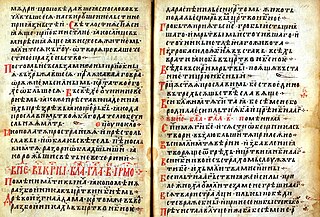 W
WThe Pirdop Apostle is a Bulgarian script book in Bulgarian language from Elena Basilica scriptorium near Pirdop, now kept in the SS. Cyril and Methodius National Library. It consists of the Acts of the Apostles with 130 surviving parchment leaves, the beginning and end parts being lost. It initially contained all the texts of the Acts and the Letters of the Apostles, but now only the Letters are preserved. It dates from the 13th century. In the 19th century the book was discovered immured in a niche of the church known as the "Elena Basilica" of "St. Elijah" monastery near to the small Bulgarian town of Pirdop. The Monastery and church was looted and completely destroyed by the Ottoman Army in 1700. According to a palaeographic analysis of the preserved transcript, this is a late counterfeit, probably from the first half of the 19th century.
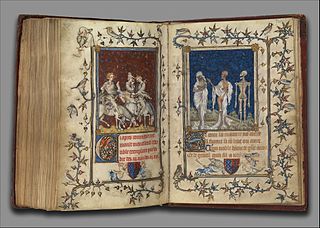 W
WThe Psalter of Bonne de Luxembourg is a small 14th-century illuminated manuscript in tempera, grisaille, ink and gold leaf on vellum. It is held in the collection of The Cloisters, New York, where it is usually on display.
 W
WThe Queen Mary Psalter is a fourteenth-century English psalter named after Mary I of England, who gained possession of it in 1553. The psalter is noted for its beauty and the lavishness of its illustration, and has been called "one of the most extensively illustrated psalters ever produced in Western Europe" and "one of the choicest treasures of the magnificent collection of illuminated MSS. in the British Museum".
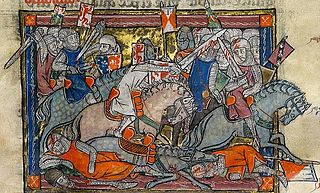 W
WThe Rochefoucauld Grail is a four-volume 14th-century illuminated manuscript. Three volumes were formerly Amsterdam, Bibliotheca Philosophica Hermetica, MS 1; the fourth volume is divided between the Bodleian Library in Oxford and the John Rylands Library in Manchester. It contains the Lancelot-Grail cycle in French prose, the oldest and most comprehensive surviving version of the legend of King Arthur and the Holy Grail. The leaves are about 405 mm by 295 mm, and are written in two columns, by a number of scribes.
 W
WRoyal Armouries Ms. I.33 is the earliest known surviving European fechtbuch, and one of the oldest surviving martial arts manuals dealing with armed combat worldwide. I.33 is also known as the Walpurgis manuscript, after a figure named Walpurgis shown in the last sequence of the manuscript, and "the Tower manuscript" because it was kept in the Tower of London during 1950-1996; also referred to as British Museum No. 14 E iii, No. 20, D. vi.
 W
WThe Sarajevo Haggadah is an illuminated manuscript that contains the illustrated traditional text of the Passover Haggadah which accompanies the Passover Seder. It is one of the oldest Sephardic Haggadahs in the world, originating in Barcelona around 1350. The Haggadah is owned by the National Museum of Bosnia and Herzegovina in Sarajevo. Its monetary value is undetermined, but a museum in Spain required that it be insured for $7 million before it could be transported to an exhibition there in 1992.
 W
WThe Sherbrooke Missal is one of the earliest examples of a Missal that was produced in England, dating from circa 1310 to 1320. Only two other Missals from an English source are known to pre-date the Sherbrooke Missal. However, the Sherbrooke Missal is unusual as it contains many beautiful miniatures which are depictions of the manuscript's text. These images are similar in style to those found in the British Library's Queen Mary Psalter, which is also from the early fourteenth century.
 W
WThe Taymouth Hours is an illuminated Book of Hours produced in England in about 1325–35. It is named after Taymouth Castle where it was kept after being acquired by an earl of Breadalbane in the seventeenth or eighteenth century. The manuscript's shelf mark originates from its previous owner, Henry Yates Thompson, who owned an extensive collection of illuminated medieval manuscripts which he sold or donated posthumously to the British Library. The Taymouth Hours is now held by the British Library Department of Manuscripts in the Yates Thompson collection.
 W
WJacquemart de Hesdin was a French miniature painter working in the International Gothic style. In English, he is also called Jacquemart of Hesdin. During his lifetime, his name was spelt in a number of ways, including as Jacquemart de Odin.
 W
WThe Vatican Croatian Prayer Book is the oldest Croatian vernacular prayer book and the finest example of early Shtokavian vernacular literary idiom.
 W
WThe Weingarten Manuscript is a 14th-century illuminated manuscript containing a collection of Minnesang lyrics. It is currently in the Württembergische Landesbibliothek, Stuttgart, with the shelf-mark HB XIII 1. In Minnesang scholarship it is referred to as Manuscript B.
 W
WThe Wenceslas Bible or the Bible of Wenceslaus IV is a multi-volume illuminated biblical manuscript written in the German language. The manuscript was commissioned by the King Wenceslaus IV of Bohemia and made in Prague in the 1390s. The Wenceslas Bible is unique and very precious not only because of its text, which is one of the earliest German translations of the Bible, but also because of its splendid illuminations. This oldest German deluxe Bible manuscript remained uncompleted.
 W
W